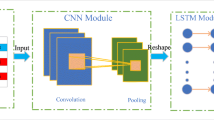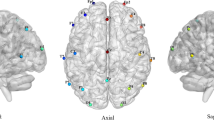Abstract
As a global and grievous mental disease, major depressive disorder (MDD) has received much attention. Accurate detection of MDD via physiological signals represents an urgent research topic. Here, a frequency-dependent multilayer brain network, combined with deep convolutional neural network (CNN), is developed to detect the MDD. Multivariate pseudo Wigner distribution is firstly introduced to extract the time-frequency characteristics from the multi-channel EEG signals. Then multilayer brain network is constructed, with each layer corresponding to a specific frequency band. Such multilayer framework is in line with the nature of the workings of the brain, and can effectively characterize the brain state. Further, a multilayer deep CNN architecture is designed to study the brain network topology features, which is finally used to accurately detect MDD. The experimental results on a publicly available MDD dataset show that the proposed approach is able to detect MDD with state-of-the-art accuracy of 97.27%. Our approach, combining multilayer brain network and deep CNN, enriches the multivariate time series analysis theory and helps to better characterize and recognize the complex brain states.






Similar content being viewed by others
References
Kessler, R.C., Berglund, P., Demler, O., et al.: The epidemiology of major depressive disorder: results from the National Comorbidity Survey Replication (NCS-R). JAMA J. Am. Med. Assoc. 289, 3095–105 (2003)
Hasin, D.S., Goodwin, R.D., Stinson, F.S., Grant, B.F.: Epidemiology of major depressive disorder: results from the National Epidemiologic Survey on alcoholism and related conditions. Arch. Gen. Psychiatry 62, 1097–1106 (2005)
Xu, D.D., Rao, W.W., Cao, X.L., et al.: Prevalence of major depressive disorder in children and adolescents in China: a systematic review and meta-analysis. J. Affect. Disord. 241, 592–598 (2018)
Miller, A.H., Raison, C.L.: The role of inflammation in depression: from evolutionary imperative to modern treatment target. Nat. Rev. Immunol. 16, 22–34 (2016)
Goldstein, B.I., Shamseddeen, W., Spirito, A., et al.: Substance use and the treatment of resistant depression in adolescents. J. Am. Acad. Child Psychiatry 48, 1182–1192 (2009)
Young, K.D., Siegle, G.J., Zotev, V., Phillips, R., Misaki, M., Yuan, H., Drevets, W.C., Bodurka, J.: Randomized clinical trial of real-time fMRI amygdala neurofeedback for major depressive disorder: effectson symptoms and autobiographical memory recall. Am. J. Psychiatry 174, 748–755 (2017)
Dunlop, B.W., Rajendra, J.K., Craighead, W.E., et al.: Functional connectivity of the subcallosal cingulate cortex and differential outcomes to treatment with cognitive-behavioral therapy or antidepressant medication for major depressive disorder. Am. J. Psychiatry 174, 533–545 (2017)
Lin, I.M., Fan, S.Y., Yen, C.F., et al.: Heart rate variability biofeedback increased autonomic activation and improved symptoms of depression and insomnia among patients with major depression disorder. Clin. Psychopharmacol. Neurosci. 17, 222–232 (2019)
Mestanikova, A., Mestanik, M., Ondrejka, I., et al.: Complex cardiac vagal regulation to mental and physiological stress in adolescent major depression. J. Affect. Disord. 249, 234–241 (2019)
Mahato, S., Paul, S.: Detection of major depressive disorder using linear and non-linear features from EEG signals. Microsyst. Technol. 25, 1065–1076 (2018)
Mumtaz, W., Xia, L., Ali, S.S.A., Yasin, M.A.M., Hussain, M., Malik, A.S.: Electroencephalogram (EEG)-based computer-aided technique to diagnose major depressive disorder (MDD). Biomed. Signal Process. 31, 108–115 (2017)
Mumtaz, W., Ali, S.S.A., Yasin, M.A.M., Malik, A.S.: A machine learning framework involving EEG-based functional connectivity to diagnose major depressive disorder (MDD). Med. Biol. Eng. Comput. 56, 233–246 (2018)
Mumtaz, W., Xia, L., Mohd Yasin, M.A., Azhar Ali, S.S., Malik, A.S.: A wavelet-based technique to predict treatment outcome for major depressive disorder. PLoS ONE 12, e0171409 (2017)
Pizzagalli, D.A., Webb, C.A., Dillon, D.G., et al.: Pretreatment rostral anterior cingulate cortex theta activity in relation to symptom improvement in depression: a randomized clinical trial. JAMA Psychiatry 75, 547–554 (2018)
Ahmadlou, M., Adeli, H., Adeli, A.: Fractality analysis of frontal brain in major depressive disorder. Int. J. Psychophysiol. 85, 206–211 (2012)
Goldschmied, J.R., Cheng, P., Armitage, R., Deldin, P.J.: A preliminary investigation of the role of slow-wave activity in modulating waking EEG theta as a marker of sleep propensity in major depressive disorder. J. Affect. Disord. 257, 504–509 (2019)
Murphy, O.W., Hoy, K.E., Wong, D., Bailey, N.W., Fitzgerald, P.B., Segrave, R.A.: Individuals with depression display abnormal modulation of neural oscillatory activity during working memory encoding and maintenance. Biol. Psychol. 107766 (2019)
Pachori, R.B., Sircar, P.: EEG signal analysis using FB expansion and second-order linear TVAR process. Signal Process. 88, 415–420 (2008)
Sharma, M., Goyal, D., Achuth, P.V., Acharya, U.R.: An accurate sleep stages classification system using a new class of optimally time-frequency localized three-band wavelet filter bank. Comput. Biol. Med. 98, 58–75 (2018)
Riaz, F., Hassan, A., Rehman, S., Niazi, I.K., Dremstrup, K.: EMD-based temporal and spectral features for the classification of EEG signals using supervised learning. IEEE Trans. Neural Syst. Rehabil. Eng. 24, 28–35 (2016)
Tian, G.L., Liu, Y.: Simple convolutional neural network for left-right hands motor imagery EEG signals classification. Int. J. Cogn. Inform. Natural Intell. 13, 36–49 (2019)
Bhattacharyya, A., Sharma, M., Pachori, R.B., Sircar, P., Acharya, U.R.: A novel approach for automated detection of focal EEG signals using empirical wavelet transform. Neural Comput. Appl. 29, 47–57 (2018)
Ahrabian, A., Looney, D., Stankovic, L., Mandic, D.P.: Synchrosqueezing-based time-frequency analysis of multivariate data. Signal Process. 106, 331–341 (2015)
de Lima, G.V.L., Saito, P.T.M., Lopes, F.M., Bugatti, P.H.: Classification of texture based on bag-of-visual-words through complex networks. Expert Syst. Appl. 133, 215–224 (2019)
Li, J., Jiang, H., Yu, Z., Hu, C.: Dynamical analysis of rumor spreading model in homogeneous complex networks. Appl. Math. Comput. 359, 374–385 (2019)
Wang, H., Wang, J., Small, M., Moore, J.M.: Review mechanism promotes knowledge transmission in complex networks. Appl. Math. Comput. 340, 113–125 (2019)
Morabito, F.C., Campolo, M., Labate, D., et al.: A longitudinal EEG study of Alzheimer’s disease progression based on a complex network approach. Int. J. Neural Syst. 25, 1550005 (2015)
Gao, Z., Dang, W., Liu, M., Guo, W., Ma, K., Chen, G.: Classification of EEG signals on VEP-based BCI systems with broad learning. IEEE Trans. Syst. Man Cybern. Syst. (2019). https://doi.org/10.1109/TSMC.2020.2964684
Lachaux, J.P., Rodriguez, E., Martinerie, J., Varela, F.J.: Measuring phase synchrony in brain signals. Hum. Brain Mapp. 8, 194–208 (1999)
Wang, M., El-Fiqi, H., Hu, J.K., Abbass, H.A.: Convolutional neural networks using dynamic functional connectivity for EEG-based person identification in diverse human states. IEEE Trans. Inf. Forensic Secur. 14, 3259–3272 (2019)
Sole-Ribalta, A., De Domenico, M., Gomez, S., Arenas, A.: Random walk centrality in interconnected multilayer networks. Physica D 323, 73–79 (2016)
Martincic-Ipsic, S., Margan, D., Mestrovic, A.: Multilayer network of language: a unified framework for structural analysis of linguistic subsystems. Phys. A 457, 117–128 (2016)
Dang, W.D., Gao, Z.K., Lv, D.M., Liu, M.X., Cai, Q., Hong, X.L.: A novel time-frequency multilayer network for multivariate time series analysis. New J. Phys. 20, 125005 (2018)
Sahneh, F.D., Scoglio, C., Van Mieghem, P.: Generalized epidemic mean-field model for spreading processes over multilayer complex networks. IEEE-ACM Trans. Netw. 21, 1609–1620 (2013)
Gao, Z., Dang, W., Mu, C., Yang, Y., Li, S., Grebogi, C.: A novel multiplex network-based sensor information fusion model and its application to industrial multiphase flow system. IEEE Trans. Ind. Inform. 14, 3982–3988 (2018)
Gao, Z., Zhang, S., Dang, W., Li, S., Cai, Q.: Multilayer network from multivariate time series for characterizing nonlinear flow behavior. Int. J. Bifurc. Chaos 27, 1750059 (2017)
Buldu, J.M., Porter, M.A.: Frequency-based brain networks: from a multiplex framework to a full multilayer description. Netw. Neurosci. 2, 418–441 (2018)
Lin, E., Kuo, P.H., Liu, Y.L., Yu, Y.W.Y., Yang, A.C., Tsai, S.J.: A deep learning approach for predicting antidepressant response in major depression using clinical and genetic biomarkers. Front. Psychiatry 9, 290 (2018)
Zhang, K., Zuo, W., Chen, Y., Meng, D., Zhang, L.: Beyond a Gaussian denoiser: residual learning of deep CNN for image denoising. IEEE Trans. Image Process. 26, 3142–3155 (2017)
Badrinarayanan, V., Kendall, A., Cipolla, R.: SegNet: a deep convolutional encoder–decoder architecture for image segmentation. IEEE Trans. Pattern Anal. Mach. Intell. 39, 2481–2495 (2017)
Dang, W.D., Gao, Z.K., Hou, L.H., Lv, D.M., Qiu, S.M., Chen, G.R.: A novel deep learning framework for industrial multiphase flow characterization. IEEE Trans. Ind. Inform. 15, 5954–5962 (2019)
Szegedy, C., Ioffe, S., Vanhoucke, V., Alemi, A.A.: Aaai, Inception-v4, inception-ResNet and the impact of residual connections on learning. In: Proceedings of AAAI Conference on Artifiial Intelligence (2017)
Gao, Z.K., Wang, X.M., Yang, Y.X., Mu, C.X., Cai, Q., Dang, W.D., Zuo, S.Y.: EEG-based spatio-temporal convolutional neural network for driver fatigue evaluation. IEEE Trans. Neural Netw. Learn. Syst. 30, 2755–2763 (2019)
Lilly, J.M., Olhede, S.C.: Analysis of modulated multivariate oscillations. IEEE Trans. Signal Process. 60, 600–612 (2012)
Myers, M.H., Padmanabha, A., Hossain, G., de Jongh Curry, A.L., Blaha, C.D.: Seizure prediction and detection via phase and amplitude lock values. Front. Hum. Neurosci. 10, 80 (2016)
A. P. Association: Diagnostic and Statistical Manual of Mental Disorders (DSM-5). American Psychiatric Pub, Philadelphia (2013)
Dien, J.J.B.R.M.: Instruments, and computers, issues in the application of the average reference: review, critiques, and recommendations. Behav. Res. Methods Instrum. Comput. 30, 34–43 (1998)
Jasper, H.H.J.E.C.N.: The ten-twenty electrode system of the international federation. Neurophysiology 10, 370–375 (1958)
Roh, S.C., Park, E.J., Shim, M., Lee, S.H.: EEG beta and low gamma power correlates with inattention in patients with major depressive disorder. J. Affect. Disord. 204, 124–130 (2016)
Acknowledgements
This work was supported in part by the National Natural Science Foundation of China under Grants Nos. 61922062 and 61873181.
Author information
Authors and Affiliations
Corresponding author
Ethics declarations
Conflict of interest
The authors declare that they have no conflict of interest.
Additional information
Publisher's Note
Springer Nature remains neutral with regard to jurisdictional claims in published maps and institutional affiliations.
Rights and permissions
About this article
Cite this article
Dang, W., Gao, Z., Sun, X. et al. Multilayer brain network combined with deep convolutional neural network for detecting major depressive disorder. Nonlinear Dyn 102, 667–677 (2020). https://doi.org/10.1007/s11071-020-05665-9
Received:
Accepted:
Published:
Issue Date:
DOI: https://doi.org/10.1007/s11071-020-05665-9




